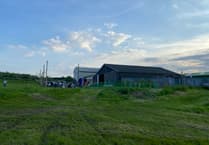EYEWITNESSES of the horrific Blackdown air crash on November 4, 1967, joined representatives of the families involved, Surrey and Sussex emergency services, Chichester MP Gillian Keegan and county, district, town and parish councils, at a packed memorial service last Saturday at St Margaret’s Church, Fernhurst.
Afterwards, Fernhurst vicar Rev Nick Haigh unveiled a memorial plaque at the village hall to mark the 50th anniversary of one of the worst air accidents in the UK.
People queued to get into the village hall on Saturday and Sunday to see the impressive exhibition mounted by Fernhurst Archive director Christine Maynard and her team, together with Fernhurst Society, the parish council, the village hall, South Downs National Park Authority and many local businesses.
Those who witnessed the harrowing event and the trail of wreckage strewn across a square mile of countryside, described their experiences of the fateful night in moving accounts included in the display.
Fernhurst’s 50th anniversary homage marked the first formal commemoration of the tragedy and for many, including freelance photographer John Fox, just 19 at the time and unprepared for the horrific sights, it was the first opportunity to talk openly and provided a welcome form of closure.
The names of the dead were read out at the service. They included British film star June Thorburn, who was five months pregnant with her third child, Coventry City Football Club vice-president John Clarkson and Donald Campbell of the Campbell Aircraft Company.
The accident is believed to have been the result of the altimeter being mis-read. At that time there was no audible warning mechanism to signal it was at a dangerous altitude.
Haslemere Fire Brigade were alerted within minutes of the crash, and were joined by firemen from Grayshott, Liphook and Guildford to support the police operation, and Fernhurst residents rallied to provide essential support.
The village hall was turned into a temporary mortuary and the Women’s Royal Voluntary Service helped provide food and drink for the emergency services from the Youth Club behind the Spread Eagle public house.
Attending Saturday’s commemorations together with retired policeman Tony Jilks, one of the first at the scene at daylight, was former police forensics photographer Malcolm Barrett, who said: “The body parts were labelled at the village hall and sent to Midhurst Hospital for the post mortems.
“I spent four days there. I did my first post mortem aged 16 so I had some experience but I had never seen anything like it. You just had to try and shut it out and do your job.”
Mrs Maynard was overwhelmed by the response to the village commemorations and exhibition.
“It occurred to me about a year ago we had no memorial,” she said.
“The exhibition was a tremendous success, we had around 1,000 visitors and people queuing to get in.
“Everyone wanted to do their bit. It was very much a community event and it really brought everyone together.”




Comments
This article has no comments yet. Be the first to leave a comment.